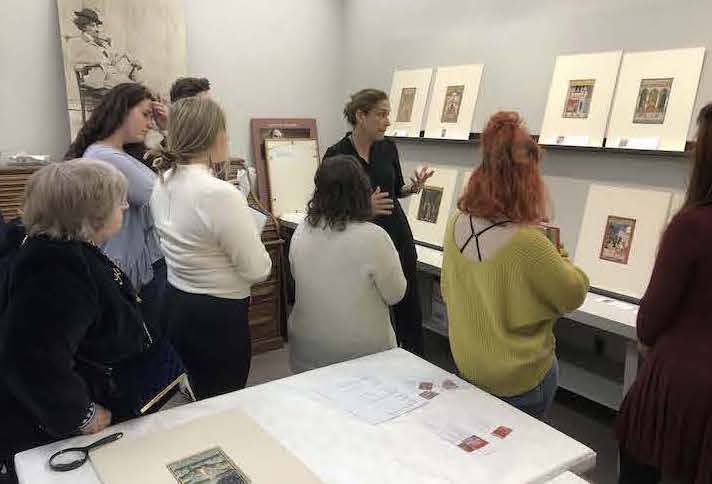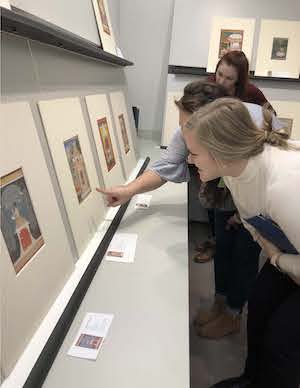
Debra Diamond (center, in black), the Freer/Sackler’s curator of South and Southeast Asian art, gives students feedback on the organization of their Ragamala painting exhibit. Photo by Robert DeCaroli.
When George Mason University students in Robert DeCaroli’s art history course left the Freer Gallery of Art and Arthur M. Sackler Gallery in Washington, D.C., on March 5, they had no idea it would be their last time inside the Smithsonian Institution museum during the spring semester.
Fortunately, they had accomplished a lot that day.
The 11 students in ARTH 495/599 Curating an Exhibit had been meeting with the curator of South Asian art and other professionals at the Freer/Sackler Gallery on Fridays while working on an exhibition of Indian ragamala paintings, from 1600 to 1800 CE, which are part of the Freer/Sackler’s collection.

One of the Indian Ragamala paintings considered for the students' online exhibit. Lent by the A.M.S. Foundation for the Arts, Sciences, and Humanities, Arthur M. Sackler Gallery, Smithsonian Institution, MLS1868 / Photo by Robert DeCaroli.
The ragamala painting exhibit was always planned as an online resource to be shared with the Freer/Sackler Gallery, so that work was able to move forward. Sadly, the in-person gallery exhibition using reproductions of the paintings, which was to take place in Buchanan Hall on Mason’s Fairfax Campus in May, was cancelled.
“I am very proud of the way the students prevailed despite the challenges,” said DeCaroli, who has taught at Mason since 1999.
Curating an Exhibit is a comprehensive, research and scholarship intensive course that takes students through exhibition planning from idea to taking down a show. Selecting from a large group of ragamala paintings, the students developed a concept and chose the objects for the ragamala exhibit. They also created marketing materials and planned gallery talks and musical accompaniment for their exhibit, which they didn’t get to implement.
The class had met several times at the Freer/Sackler where DeCaroli has a professional connection. DeCaroli is a co-curator of the Encountering the Buddha: Art and Practice Across Asia exhibit (currently running at the Sackler Gallery through 2022) with Debra Diamond, the Freer/Sackler’s curator of South and Southeast Asian art.
Diamond introduced the class to many of her colleagues at the museum. On this particular Friday, they spoke to the design staff and got a behind-the-scenes look at exhibition design, getting into the nitty gritty of fonts, colors, lighting, and sight lines. They also got some tips for the Buchanan Hall installation from the professionals.
For the exhibit, the students each chose two paintings to research and write about. At the Freer, they were able to spend some time with their chosen paintings. Then Diamond reviewed the students’ ideas for the progression of the exhibit and how the paintings connected to each other in theme and content. The group then decided on the order of paintings and finalized the number that would be included.

Students in the Curating an Exhibition class had the opportunity to get a good look at the Indian Ragamala paintings they were researching and writing about. Photo by Robert DeCaroli.
“It’s about creating an immersive experience for the viewer,” said Diamond.
Homework for the class, which was a mix of undergraduate and graduate students, was to return from spring break with title suggestions.
Art history MA student Kelsey Roberts, who was taking the class for a second time, played a large role in creating content for and editing the website.
“I really want to work in the museum space, and curating is such an important skill,” said Roberts, who graduated in May.
Art and visual technology major Grant Schultz is a painter who is also working on a minor in art history. He chose the course because he believed it would help him when working on exhibits, including ones of his own work. He also really wanted to bring the artist’s perspective into the curation process.
Art history graduate student Elizabeth Denholm blogged about her experience with the exhibit for the Freer/Sackler website.
“We wanted the online exhibition to reflect our own intimate experience studying the unframed paintings in museum storage and to allow viewers to be closer to the artwork than they could be in traditional museum galleries,” wrote Denholm, who also graduated in May.
The student’s online exhibition titled "Emotion and Devotion: Ragamala Paintings of India's Princely Courts" is now available online at www.ragamalaexhibit.com. And their professors are pleased.
“The students created something sophisticated and elegant online that would easily shine in a bricks-and-mortar art museum,” said Diamond.
“While we were hoping to have an on-campus event with music and snacks, current events forced us to move online,” said DeCaroli. “We do provide links to music on the site, but you'll need to supply your own snacks. The silver lining is that the Smithsonian will be linking to our page, which is a great way to showcase the students' hard work.”
